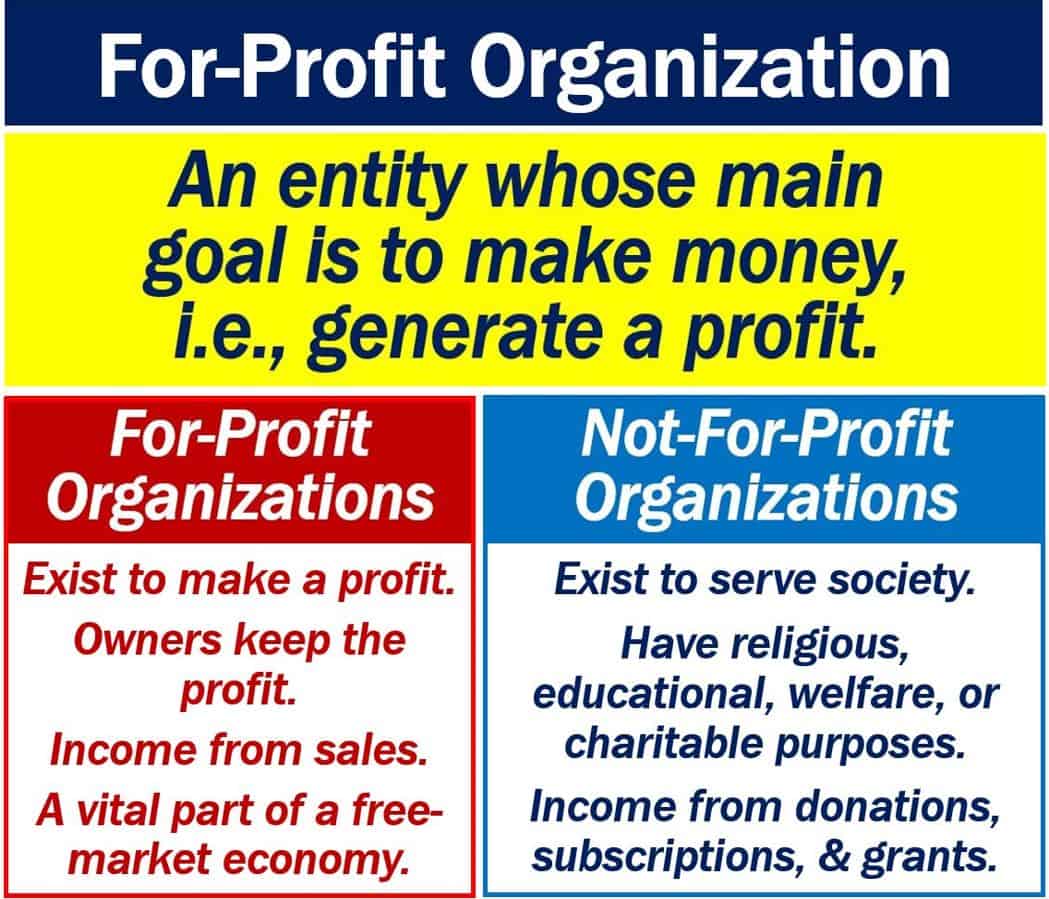A For-Profit Organization is one whose main goal is to make money, i.e., make a profit. It contrasts with a non-profit organization or not-for-profit organization which focuses on keeping itself going. Non-profit organizations usually have other non-business goals, such as helping the community.
In contrast, for-profit entities often prioritize innovation and expansion to increase their market share and overall financial health
We can write the term either with or without a hyphen, i.e., ‘for profit‘ or ‘for-profit.’ However, whichever style you choose, make sure you stick to it within a text; do not switch from one to the other in the same article.
Most businesses worldwide
The vast majority of businesses across the world are for-profit organizations. Your local corner shop, restaurant, and supermarket are all for-profit organizations.
We also refer to a for-profit organization as a for-profit corporation or commercial enterprise. If I tell somebody that I have a business, they will understand that as a for-profit organization.
The Free Management Library has the following definition of the term:
“A for-profit organization exists primarily to generate a profit, that is, to take in more money than it spends.”
“The owners can decide to keep all the profit themselves, or they can spend some or all of it on the business itself.”
Owners of for-profit organizations might also share some of their profit with their workers. In other words, they can have a profit-sharing scheme.

For-profit organization – income
For-profit organizations seek to generate income for their owners. Some also seek to generate income for their employees.
These types of organizations measure their success according to their sales. They also measure their success according to their profit.
If a company has more revenue than costs at the end of the year, it is profitable. A profitable business is a successful for-profit organization.
A company whose revenue is smaller than its costs is making a loss. In the world of for-profit organizations, it is unsuccessful.
For-profit organization types
For-profit organizations can be either private or public companies.
-
Public companies
A public company is a for-profit organization whose shares members of the public can buy on a stock exchange.
We can also purchase public company shares over-the-counter.
The stocks of a typical public company belong to many different investors. Members of the public, corporations, pension funds, and mutual funds, for example, are investors in public companies.
In this context, the word ‘stocks‘ means the same as ‘shares.’ Hence the term ‘stocks and shares.’
-
Private companies
A private company is also a for-profit organization (in most cases). Members of the public and other entities, however, cannot buy and sell its shares freely.
The purchase and sale of private company shares take place privately.
For example, if I want to buy shares in John Doe Ltd., I must approach the company directly.
If a shareholder agrees to sell me shares, I can then buy them. However, in many cases, that shareholder will need the consent of the other shareholders.
We also call private companies close corporations or privately held companies.
These privately held entities often have the flexibility to make quick decisions, an advantage that can be pivotal in adapting to market changes and pursuing innovative strategies.
Example sentences
In the seven sentences below, you can see how we can use the term “for-profit organization” in context:
- “The new startup quickly evolved into a successful for-profit organization by capitalizing on untapped market demands.”
- “While the primary goal of a for-profit organization is to maximize earnings, many also engage in social responsibility programs to give back to the community.”
- “Investors are typically more attracted to a for-profit organization because of the potential for higher financial returns on their investments.”
- “During the seminar, we discussed how a for-profit organization differs from a non-profit in terms of tax obligations and revenue distribution.”
- “The for-profit organization was lauded for its innovative approach to sustainability, proving that environmental consciousness can coexist with profitability.”
- “In economics class, we learned that a for-profit organization operates with the intention of generating surplus revenue that can be reinvested or distributed among shareholders.”
- “The for-profit organization faced scrutiny for prioritizing profits over the quality of their products, sparking a debate on corporate ethics in the modern marketplace.”
Video – What is a For-Profit Organization?
This educational video, from our sister channel on YouTube – Marketing Business Network, explains what a ‘For-Profit Organization’ is using simple and easy-to-understand language and examples.
